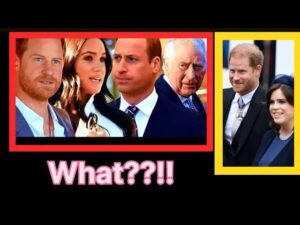In recent times, the UK media has been weaving a complex narrative surrounding the royal family, particularly focusing on the relationships between Princess Eugenie and the Duke and Duchess of Sussex, Harry and Meghan.
This ongoing saga reveals a familiar pattern — one where the media fabricates stories, plants seeds of speculation, and then twists the narrative to fit its own agenda.
Take, for instance, the recent buzz about a supposed Christmas invitation extended by Harry and Meghan to Princess Eugenie.
The media quickly jumped on this story, suggesting that the couple reached out to Eugenie in a gesture of goodwill.
However, this claim was not confirmed by Harry and Meghan themselves; rather, it was a fabrication spun by the media, designed to provoke public interest and discussion.
Once the story gained traction, the media did what it does best — they flipped the narrative.
After a week of speculation, reports surfaced claiming that Eugenie had declined the invitation.
This clever twist allowed the media to reinforce their ongoing theme that even the closest royal relatives are distancing themselves from Harry and Meghan.
It’s a classic case of creating a story, letting it simmer, and then reshaping it to fit an established narrative.
This pattern is not just predictable; it’s almost formulaic.
The UK media seems to have a playbook for crafting tales that depict Harry and Meghan as outcasts within the royal family.
The players may change, but the storyline remains unchanged, highlighting the media’s knack for sensationalism over substance.
A significant factor in these narratives is the reliance on anonymous sources.
These elusive informants often provide the juiciest details, but they remain faceless and unverified.
Who are these sources?
What are their motives?
While anonymity can sometimes protect whistleblowers or insiders, it also opens the door to misinformation and unchecked speculation.
In the case of the alleged snubbing of Harry and Meghan’s invitation, the details were again sourced from these anonymous figures.
But we must ask ourselves: who really has the inside scoop on the royal family’s private matters?
Are these sources genuine insiders, or merely constructs of the media’s imagination?
The media’s dependence on such sources raises questions about the integrity of the narratives being presented.
When the foundation of a story is built on the whispers of anonymous informants, it becomes easy to manipulate public perception.
These sources can serve as puppet masters, shaping opinions while remaining hidden from scrutiny.
Another recurring theme in these narratives is the concept of shunning.
The media loves to paint a picture of isolation, particularly when it comes to Harry and Meghan.
By suggesting that they are rejected even by their own family members, the media creates a dramatic storyline that captures public attention.
It’s as if they are playing a game of chess, moving pieces around to generate conflict and intrigue.
However, the reality is often far less dramatic.
Just because Princess Eugenie allegedly declined an invitation does not automatically imply a rejection.
It could simply be a matter of scheduling conflicts or personal choices.
Yet, the media spins this into a tale of familial estrangement, feeding a narrative that thrives on division and conflict.
As we dissect these narratives, it becomes clear that they are often devoid of truth and rooted in sensationalism.
The media crafts these stories not just for the sake of reporting, but to create a spectacle that keeps audiences engaged, even if it means distorting reality.
Ultimately, the predictable patterns of the UK media’s narratives remind us to approach such stories with a healthy dose of skepticism.
The narratives surrounding Harry, Meghan, and Eugenie are just one example of how easily misinformation can spread when sensationalism takes precedence over factual reporting.
As consumers of news, it’s essential to discern fact from fiction and question the motivations behind the stories we encounter.
The media landscape is rife with narratives that may entertain but often lack substance, and it’s our responsibility to sift through the noise for the truth.
